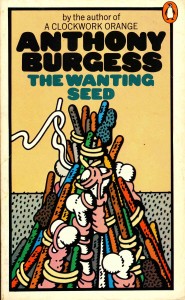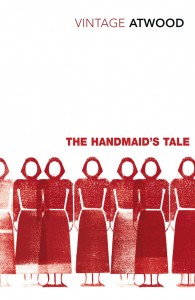Dystopian Fiction
This resource places Anthony Burgess’s writing in the context of the other dystopian novels of the period.
- Dystopian Fiction
- Dystopias: Burgess’s Introduction to The Aerodrome by Rex Warner
- Dystopias: Burgess’s Favourite Dystopias
- Dystopias: An Extract from The Novel Now
- Dystopias: The Wanting Seed and the politics of fertility
- Dystopias: Burgess and George Orwell
- Dystopias: Burgess and Aldous Huxley
Dystopias: The Wanting Seed and the politics of fertility:
 Overpopulation and the technology of human reproduction have often been the focal points of the futuristic fiction. In Aldous Huxley’s Brave New World reproduction is controlled by the state by outlawing reproductive sex and cultivating embryos in test tubes. In George Orwell’s Nineteen Eighty-Four sex between unmarried couples is outlawed, and we see the threatening presence of the ‘Anti-Sex League’.
Overpopulation and the technology of human reproduction have often been the focal points of the futuristic fiction. In Aldous Huxley’s Brave New World reproduction is controlled by the state by outlawing reproductive sex and cultivating embryos in test tubes. In George Orwell’s Nineteen Eighty-Four sex between unmarried couples is outlawed, and we see the threatening presence of the ‘Anti-Sex League’.
After the Second World War, the so-called ‘baby boom’ increased the population of the Western world. With better medical care improved standards of living came longer life-expectancy, higher birth-rates, and a decline in child mortality rates. Burgess writes in You’ve Had Your Time: ‘I had lived in the pullulating East and re-read Thomas Malthus: indeed, I was to write a definitive study of him for a learned American journal. There would, some day, be too many mouths to feed. This was not apparent in the West, except on Oxford Street.’ From these observations, Burgess wrote a dystopian novel about overpopulation and famine: The Wanting Seed, published in 1962 and sometimes described by the author as ‘a Malthusian comedy’.
The novel deals with the growing power of the State to impose controls on its citizens. Set in an unspecified future, the story describes a world where governments are struggling to maintain order in the face of food shortages and densely-populated cities. The future London, where the protagonists Tristram and Beatrice Foxe live, extends from the south coast of England to Birmingham. To combat the rising population, the totalitarian Ministry of Infertility polices the populace with ‘greyboys’, encouraging same-sex relationships with the slogan ‘It’s Sapiens to be Homo’. From this set up, Burgess embarks on his exploration of global famine and military dictatorship.
The Wanting Seed is not the only dystopia dealing with reproductive freedom and overpopulation in the 1960s. In Burgess’s world, the failure of birth control leads governments to control the populace by eliminating citizens through orchestrated wars whose sole purpose is to kill people. Logan’s Run, the 1967 novel by William F. Nolan and George Clayton Johnson, depicts the future world of 2116, where citizens are executed with a pleasure-inducing toxic gas as soon as they have reached the age of 21. Overpopulation is also the subject of Make Room! Make Room! by Harry Harrison, a 1966 novel, later adapted as the film Soylent Green (1973), starring Charlton Heston. As with The Wanting Seed, the film’s solution to famine caused by overpopulation is to convert people into food, the ‘soylent green’ of the title. Burgess claims in his autobiography that ‘Harry Harrison, on his own confession during the downing of a bottle of Scotch in my New York flat, stole the ending for the film of his novel No Room! No Room! [sic] called Soylent Green.’ Burgess may have misremembered this. As the writer Ramsey Campbell has noted, the novel has a different ending, and Harry Harrison was excluded from the production of Soylent Green by the film-makers. It is clear that many themes and ideas are shared between The Wanting Seed and the film version of Soylent Green, although Harrison himself seems not to have been responsible for the plagiarism.

In more recent times, sexual and reproductive freedom has remained a concern of dystopian novels, but with a different emphasis. One of the most significant works is Margaret Atwood’s The Handmaid’s Tale, published in 1985. Set in the Republic of Gilead, a fictional state within the borders of the future United States, where there is declining fertility and the need for ‘handmaids’, women who are still able to conceive and have been bound in sexual slavery by the ruling class. The narrator Offred, a ‘handmaid’ owned by the Commander, is forbidden from reading and has vivid memories of her life before the installation of a Christian fundamentalist government. The novel is a critique of religious right wing politics and a feminist discussion of the role of women in society. Burgess’s knowledge of Atwood’s novel is confirmed by the presence in his book collection of an early paperback edition of The Handmaid’s Tale.
In 1992, the crime writer P.D. James published Children of Men. Like The Handmaid’s Tale, it deals with questions of fertility and is a state-of-the-nation novel. In James’s vision of the future, set in 2021, there has not been a human birth since 1994, and Britain has become a dictatorship. The protagonist, Theo, is recruited by a mysterious group to overthrow the tyrannical government and protect the only pregnant woman in the world. These two novels suggest that different anxieties emerged in the later twentieth century. After the ‘free love’ era of the 1960s and 1970s, ideas of sexual intimacy became entwined with images of disease and death, following the emergence of a new incurable sexually-transmitted disease. Burgess claims that Aids ‘reminds us that there are limitations to our sexual freedom,’ just as syphilis did in the past and new diseases will in the future.
Dystopian writing continues to focus on ideas of sex, reproduction and fertility. Novels such as The Road by Cormac McCarthy, which shows women who are in sexual slavery to produce babies for food in a post-apocalyptic wasteland, continue to push dystopian fiction into dark and complex territory. In other media, films such as Gattaca (1997) and In Time (2011) involve future worlds with totalitarian controls population numbers.
The threat to reproductive freedom in dystopian novels is often used as a metaphor for wider social freedoms. The principle of family life being free from intervention by governments is a major element in discussions about human rights. Dystopian fiction often questions the limits of state power, and it contributes to ongoing debates about how many new lives should (or should not) be created, to ensure the future happiness of all citizens.


